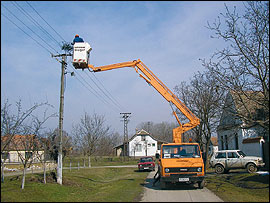 |
Safe nests for white storksWhite storks in Serbia and Montenegro are breeding in safer nests thanks to a project that provides the birds with specially designed platforms that support nests a safe distance from dangerous electrical wires. |
 |
More than 60 specially
designed platforms were
installed before the spring
arrival of storks in ten priority
project settlements.
Each platform, fixed to
the pylon, holds the nest
construction at a safe
distance from electrical
wires. |
The White Stork is one of the most famous birds in Europe. White storks
nest in a variety of structures, traditionally preferring straw stacks.
New practices of straw conservation, however, have made these breeding sites
scarce, and storks have turned to rooftops and electricity poles for nests
in recent years. The number of nests on electricity poles has increased
throughout the Carpathian Basin as small-span wires and poles are selected
by birds as ideal for supporting heavy nests. A third of all white stork
pairs in the Serbian province of Vojvodina breed in such niches.
The risk of breeding in such nests is high. Birds, as well as nests situated
on wires, can cause a fatal short circuit, if they complete an electric
circuit between the live and grounds wires. Even more frequently, death
occurs for birds when spanning the gap between a wire and a grounded power
pylon. Bird-related accidents and short circuits also cost the electric
company time and money, and removing the nests after the breeding season,
while banned, doesn't prevent birds from returning the following season.
Designed to project.
The Bird Study and Protection
Society of Vojvodina, working with provincial power
company Elektrovojvodina, have developed a solution.
Experts installed 61 specially designed platforms
to support stork nests at a safe distance from wires.
Results from the project, which is supported by the
Royal Netherlands Embassy in Serbia and Montenegro,
have shown that since being installed in spring
2005, storks have occupied 87% of the new platforms
and bred in safe nests. "This project has solved two
problems," said Dragan Babic , Development Director
of Elektrovojvodina. "Endangered birds will benefit
from this conservation action and our costs caused by
their activity will be minimal."
BREEDING BOXES ENSURE SURVIVAL OF DECLINING ROLLER IN VOJVODINA
To support efficient and timely flood forecasting
and flood warning the European Flood Alert System
(EFAS) is also being developed by EC JRC in Ispra
for the Danube River Basin. During floods in summer
2005 the EFAS team sent external information
reports to partners in Germany, Slovakia, Hungary
and Austria. The historical discharges at the alpine
streams on August 23, for example, were signalled
by EFAS from August 20 onwards. The performance
of EFAS during these events demonstrated the
benefit of using a combination of deterministic and
probabilistic flood forecasts.